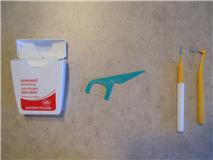Flossing: The Neglected Routine
Posted: May 8, 2011
Last Modified: September 21, 2020
Just as important as brushing, flossing requires little time but pays big dividends in that it prevents more expensive problems down the road. Since there is no way to brush between your teeth with your toothbrush, the cleaning must be done with something else. Your options are:
1) Floss: this is by far the best method. Use regular thickness unwaxed floss (the only place that we can find it at the moment is the house brand at Rexall/Pharmaplus pharmacies – for some reason Butler has discontinued it for Canada), and make sure you are using good tension up and down against the teeth that the floss lies between. Try not to perform a “shoeshine” back-and-forth movement. Unwaxed floss should squeak louder and louder as your teeth become cleaner. Once it gets no louder, move on to the next tooth! Also make sure you are getting slightly below gum level as well. Once a day is the recommended minimum, but if you wear a denture or know that food traps easily between teeth, then the best time to floss would be immediately after eating.
2) Flosspicks: this is a popular option for those with difficulty getting floss between the teeth (for example, kids or those with gagging problems). While not as good as floss because of lower tension on the length of floss on the pick, the technique should be the same.
3) Proxybrushes: these are little pipe-cleaner-like appliances that allow good cleaning in between teeth if the space between teeth is large enough. These are used in a back-and-forth motion. Typically suitable only for those who have lost teeth and drifting of remaining teeth, or those who have suffered some degree of recession that has opened up space between the teeth.

As always, please give us a call to obtain customized recommendations for yourself.
Happy cleaning between the teeth!


